Sea-Grapes: Coastal Caterer
A lifetime ago I spent many a night on a dark Florida beach near the Space Center sleeping out under Sea-Grapes. Now they would arrest you for trespassing if not threats to national security, one of the disadvantages of more people and more lawyers. But, oh what fun we had.
I can well remember the first time I saw Sea-Grapes: How exotic looking! Huge round leaves, racemes of edible fruit, large, dense stands with natural canopies underneath. Great sites for romantic rendezvous full of promise. I even wrote a few love letters on the dry leaves…composed on the spot, of course….
Sea-Grapes (Coccoloba uvifera koe-koe-LOE-buh yoo-VIFF-er-uh) are gangly, sprawling bushes or small trees found near beaches throughout tropical America and the Caribbean, including mid- and southern Florida and Bermuda. They’re also landscapes plants inland with ambitious growth. I have two species in my yard at least 90 miles outside of their accepted range, a carambola and a sea-grape. Sea-Grapes reach a maximum height of 50 feet or so under prime conditions but most are around 10 feet tall locally. The bark is smooth and yellowish. In late summer it bears green fruit, about the size of a large marble, in large skinny grape-like clusters that turn purple (think of two elephant ears and a nose, except the ears are leaves and the nose a long, skinny string of grape-like fruit.) To say the fruit has a pit is an understatement. The fruit is mostly pit. When ripe the fruit can be eaten right off the tree or used for jelly. Besides jelly, the fruit can also be made into wine. A gum or resin from the bark has been used for throat ailments and the roots used to treat dysentery.
Officially the tree is unable to survive frost. But mine has survived several and two light freezes of just 32 degrees for a few hours. It is moderately tolerant of shade, but will grow towards the sun. It’s very tolerant of salt so it is often planted to stabilize beaches. The wood of older trees is highly prized for cabinet making and boiling the wood yields a red dye. Sometimes leaves veins are red.
Dr. Julia Morton, who wrote “Wild Plants for Survival In South Florida” said of the Sea-Grape: “Shrub forming clumps on exposed beaches, or large trees… branched close to the ground acquiring broad, massive rounded head…. young leaves silky bronze, old leaves turn yellow or red and fall a few at a time. Flowers whitish, tiny, in “rattail” spikes four to 12 inches long, fruit, greenish-lavender or reddish-purple, slightly velvety, plump-oval or pear-shaped, 3/4 of an inch long, in compact, grape-like clusters. Flesh thin, juicy, acid to sweet, musky, covering single, plump, sharp-pointed, hard, brown seed with ivory tip… Leaves are useful as plates or, pinned together with twigs or thorns, can be made into hats, also serve as emergency notepaper.”
A member of the buckwheat family, Sea-Grapes were named twice. Its first botanical name was Polygonum uvifera, in 1753, reflecting that it is in the buckwheat family. The Coccoloba genus was created in that family and the Sea-Grape was slightly misnamed Coccolobis uvifera by Nickolaus Joseph von Jacquin — must not have known his Dead Latin. Linnaeus, the original namer, came back in 1759 correcting the name to Coccoloba uvifera. Coccoloba comes from “cocolobis” a type of Spanish grape; uvifera means “bearing grapes” or “like grapes.” Jacquin, incidentally, started out as a professor of Minerals and Mining at a Mining Academy in Slovakia. In 1768, he was appointed Professor of Botany and Chemistry and became director of the botanical gardens of the University of Vienna. For his work, he was knighted in 1774, made a baron in 1806. His youngest son, Emil, and his daughter, Franziska, were close friends of a hot composer of the time with several big hits, Wolfgang Mozart.
Three more things: Sea-Grapes are an important honey source, they make a good bonsai candidates, and a patent was filed in 1999 to use leaf extracts to control blood sugar levels in diabetics. Oh, and the tree is protected in Florida. It is illegal to destroy them. More specifically, you cannot harvest from public land. On Private land you need the owner’s permission. Here is the statute:
161.242 Harvesting of sea oats and sea grapes prohibited; possession prima facie evidence of violation.—
Green Deane’s “Itemized” Plant Profile
IDENTIFICATION: A seaside, warm-climate tree with huge round leaves with red veins, a shrub near the north of it range, a tree in its range.
TIME OF YEAR: Bears fruit in late summer or fall.
ENVIRONMENT: Native to coastal areas such as Florida and the West Indies. Can be grown inland in freeze-protected areas. In Florida rarely north of Daytona Beach on the east coast and St. Petersburg on the west coast. It is also found in Puerto Rico, the Virgin Islands and Hawaii. It is not reported in Mississippi but is found on the coast of Alabama. Naturalized in Mexico south to northeastern Brazil and on the Pacific south to Peru.
METHOD OF PREPARATION: Ripe red fruit out of hand off the tree or made in to jelly or wine.

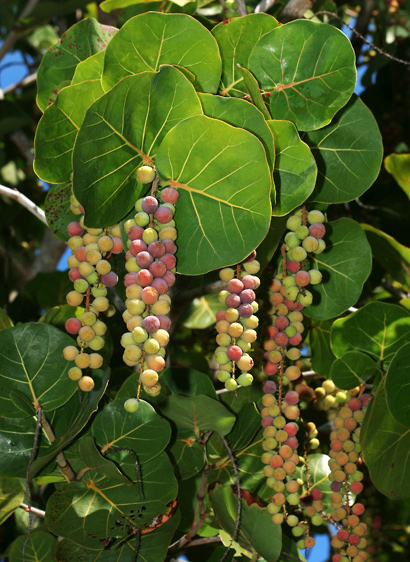
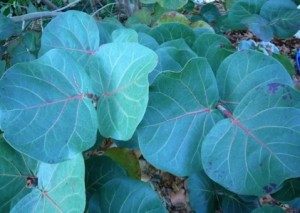
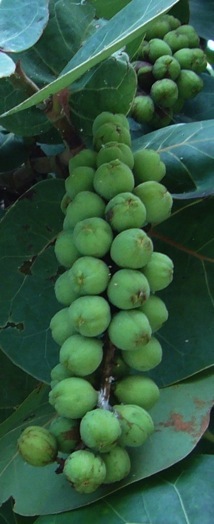
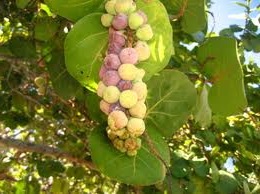

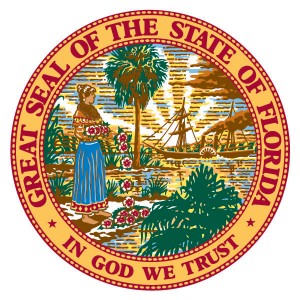
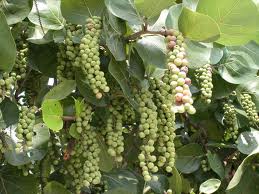

I’d like to know more about the diabetic part I’m an insulin dependant diabetic, live in south florida, and love to hunt and be with nature.if ever apostates from my insulin I would like to know something that would help my insulin levels.do you make a tea from the green leaves? I’m not the kind of guy to sue anyone but if you know of any plants in florida that would help please let me know.by the way this is THE BEST WEBSITE I’ve found to identify plants and their uses, thank you so much for making it I just knew God didn’t create a bunch of useless weeds all over the earth.
A better plant to look into would be Momordica charantia. It is called the vegetable insulin.
Thats the bitter melon right? Any idea how it can be eaten? The only thing I read was about using non ripe “melons” removing the seeds and pulp then juicing and not to drink to much cause of the diarreah affect but most of the other language the website was speaking in was way too scientific for me to understand.
You need to visit the Bitter Melon entry if we are going to discuss that plant. This page is about Sea grapes.
Bitter melon is great in salads. Also there’s a good recipe in the Cooking with Qi cookbook!!! I think you can get it on Amazon.
In the past few years I have used sea grapes to make jellies and sorbet. However I have never tried to make wine before and am curious about it. Is this a good fruit to start with? and if so any suggestions where to obtain a recipe?
I did a cursory search and came up with one recipe that called for what seemed like a huge amount of sugar.
BTW great site, and keep up the good work.
Most basic fruit wine recipies are the same. The fruit pulp doesn’t hav much sugar but too much sugar will make a sweet wine.
Can the sea grape be grown succesfully from seed? If I buy an etablished plant will I need two for pollination?
Thanks for the wonderful videos on YouTube. My kids and I really like your programs.
Yes they can be grown from seed and as far as I know they are self pollinating.
We may have male and female plants. One bears grapes the other does not.
For future readers, since it’s been a long while since “Bob” above posted, I grew up with one in my yard (AMAZING climbing tree for a kid – ours was probably near the top end of the height spectrum) and we never had fruit. The above comment, my childhood experience and the fact that it’s cousin, Cocoloba diversifolia (Pigeon Plum), is dioecious (having male and female plants thus fruits only on the female) leads me to believe C. uvifera is also dioecious (so, yes, a male and female not too far from one another would be needed).
There are good and bad years for sea grapes. There are also ants that systematically eat all the leaves off trees, which then take a couple of seasons to recover. We have used a hand-held cherry-pitter to separate seed from fruit for making jelly, juice and sorbet. A neighbor makes sea-grape cheesecake, which is great. Does anyone know if the seed is edible?
I was also wondering if the seed is edible since it makes up about 80% of the fruit.
Not that I know of.
The squirrels have been eating some of the ripe fruit from my trees and they are leaving the seeds on the ground under the tree, so that may be a good indication that they are best used to make new trees.
I am looking for a relatively fast growing tree that will work in Southern California about 1 mile from the ocean in sandy soil (hardiness zone 10). We are looking for a tree that can get to 30 or 40 feet (more is fine, but we certainly don’t want one under 25 feet).
Research revealed that a Sea Grape tree might be a good choice. I found your comment that said: “Sea-Grapes reach a maximum height of 50 feet or so under prime conditions but most are around 10 feet tall locally.” That said, I am wondering if you could provide me any info under what the prime conditions are that would allow a Sea Grape to grow 25+ feet, versus the 10 feet that you are seeing locally?
Any information you can provide would be appreciated. Thank You.
Can sea grape grow successfully in Southern California inland? I’m at approx. 2000 FT. altitude on a south slope. I grow successfully all sorts of citrus, plums, apricots, nectarines, low-chill apples, and real tea (Camellia sinensis). Thanks.
The answer is yes, and quite successfully, too.
Thank you! This will be fun. One more question: do I have to worry about infestations or infections? Parasites?
Can you freeze sea grapes or sea grape juice and make the jelly at a later date?
Yes, but they are mostly seed and when you’re done the jelly will taste like apple jelly.
Can I produce the juice (getting rid of the seed) and freeze it for canning later?
Yes, but they really are best eaten as they are.
Is there any info on whether the leaf is edible, if cooked or blanched?
As far as I know the answer is no. I also checked my books and there is no reference to edible leaves.
I have eaten the leaf and lived. It leaves a chalky flavor in the mouth and leaves your mouth feeling dry but hey, it didn’t kill me and I have consumed the leaf on more than one occasion. The grape is both sweet and salty. There is a very good way of using the leaf though. Gather aprox 10 green leaves and place in a crock pot and simmer on low to medium until the water changes to a purple color. Then take leaves out and pour into a glass container and allow to cool then refrigerate. Quite refreshing drink I must say! I used 1 cup at a time for lowering my blood sugar levels.
Thank you so much for developing this website! We went to Ft. Myers last month to visit my father in law, at the beach I saw hundreds of Sea-Grape plants, although I didn’t know what they were. A couple of leaves had broken off and were floating in the ocean, I gathered them and brought them home to Tennessee! By the time we returned home, they had dried and turned brown, I re-saturated them and it was as beautiful as when I gathered it from the water! I dries it flat and put it in a shadow box with a giant sand dollar I got on the trip. I searched every combination of words trying to figure out what the plant was. Finally i typed in giant red round leaves and I found your site! It’s extremely informative and enjoyable! Thanx for the information, I can finally tell everyone what it is when they ask!
since the fruit ripens at different rates and if I want to make jelly, could I collect the ripe red fruits (before they turn white) and freeze them until I have enough to make the 4 cups of fluid (I know how to do this part).
Mainly my question is can I freeze them until I have enough to make jelly? So excited to make jelly!
oops sorry my mouse must have skipped over that Q/A the first time. Yes to freezing. Yay! Which is better in your opinion freeze the fruit or make the juice for the jelly and freeze the juice?
Looking for recipe for sea grape Jelly, jam and candy….thanks …JN
Is it possible to have sea grapes in central fl near the coast?? I have a plant in my yard that really looks like it. I am close to the intercostal
Bill
Yes but they don’t become big trees here, maybe eight to 10 feet high or so.
I am in the Daytona Beach area, Zone 9, about 3 miles inland. As a member of FNPS, my garden is 90% Florida natives. Six years ago I planted 3 sea grape bushes, which remained waist-high until this year. They would freeze back every winter. We had no frost in 2013-14, and last summer was exceptionally wet and rainy. The Sea Grapes took off. They are about 15′ high. I’ve never had any fruit, but one bush has flower stems on it – probably I have all females, as I know I have plenty of bees.
Is it against the law to remove or relocate the plant???????
Do sea grapes need protection from frost???????.
They don’t like frost and don’t grow well in Central FLorida because of the occasional cold weather here.
I have a red fruit the size of a golf ball that taste alot like a blackberry on the inside, the skin is very smooth, it is in my backyard in Daytona Beach, does anyone know the name of this fruit or the tree? Thanks, Robert A. Harris
A picture helps… this time of year? Does it have big thorns? Try Natal Plum.
Do Sea grape actually spread all around your yard, if you’d plant one there?
I live in St. Petersburg and sea grape trees every where. My husband and I would like to buy one but are not sure of the best time to plant. Does anyone know when we should be planting?
Thanks!
Amber:
Just take a hand ful of ripe grapes, just fallen from the tree, dig a hole in the wet sand, or in soft earth, drop the grapes, cover the hole, wet it regularly and wait two or three weeks. Or, easier, run to the nearest tree and dig two or three plantulets, growing from the grapes falling off the trees. Good luck and glad to have helped.
We have sea grape plants growing all over on South Padre Island, Texas. Some are growing right on the beach and are over 2 stories high! I never knew they were edible. Beautiful plants. Messy when the over ripe grapes drop all over the sidewalk. Massive.
The Greeks , I think, roll ground lamb, pork and beef with seasonings and cook in grape leaves, which I remember as edible along with the meat. Are sea grape leaves suited for this use? I have plenty.
No, not at all. They just share a common name but not use.
Looking to grow sea grapes in a good size container. Clearwater Fl. area, near the Gulf. Is this possible? Many thanks for this website. JIM
Native Americans used the entire plant actually. they used the leaves in a tea as well as the bark to treat certain ailments such as asthma. What i’ve seen is that parrots on other birds like to eat the inside of the seed,like a nut. However, it is bitter to the taste.
I have a large Sea Grape tree in my back yard. Yesterday I had some of the branches trimmed that hung over the pool. I took off all the grapes but they were not ripe yet. Will they get ripe if I put them in the sun.
Can I use them when they are not ripe? I made jelly last year everyone loved it but the grapes were purple. These are still white can I use them.